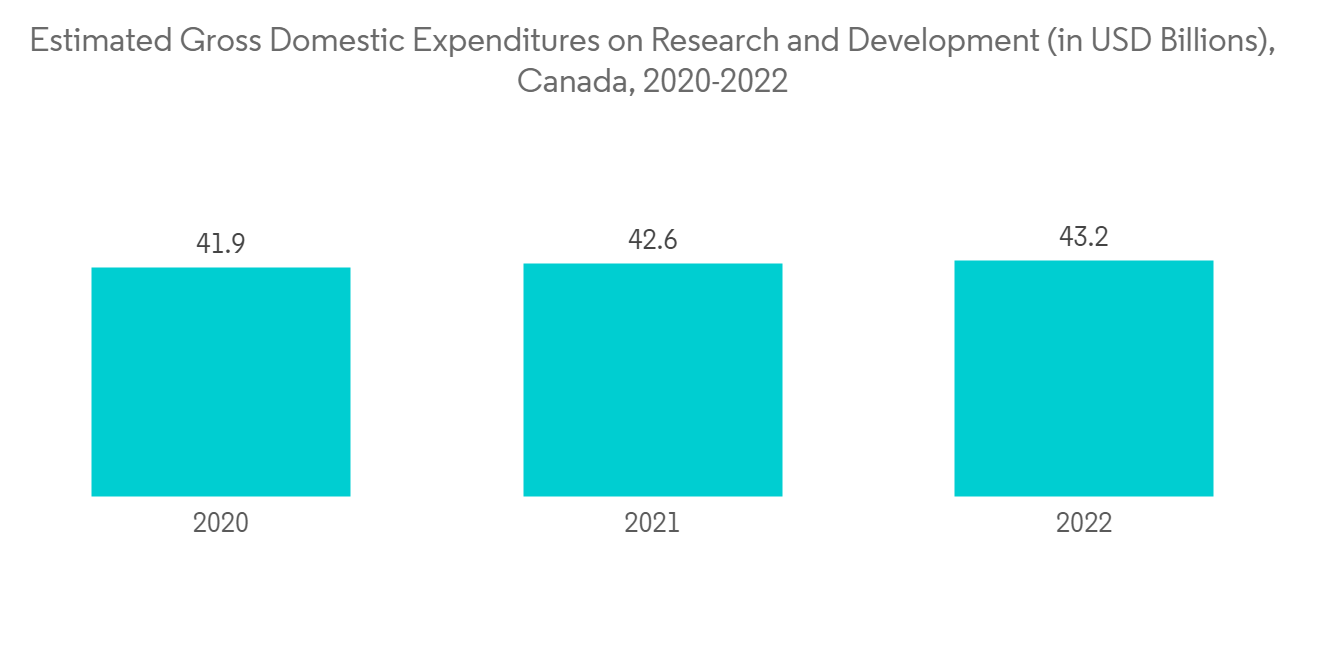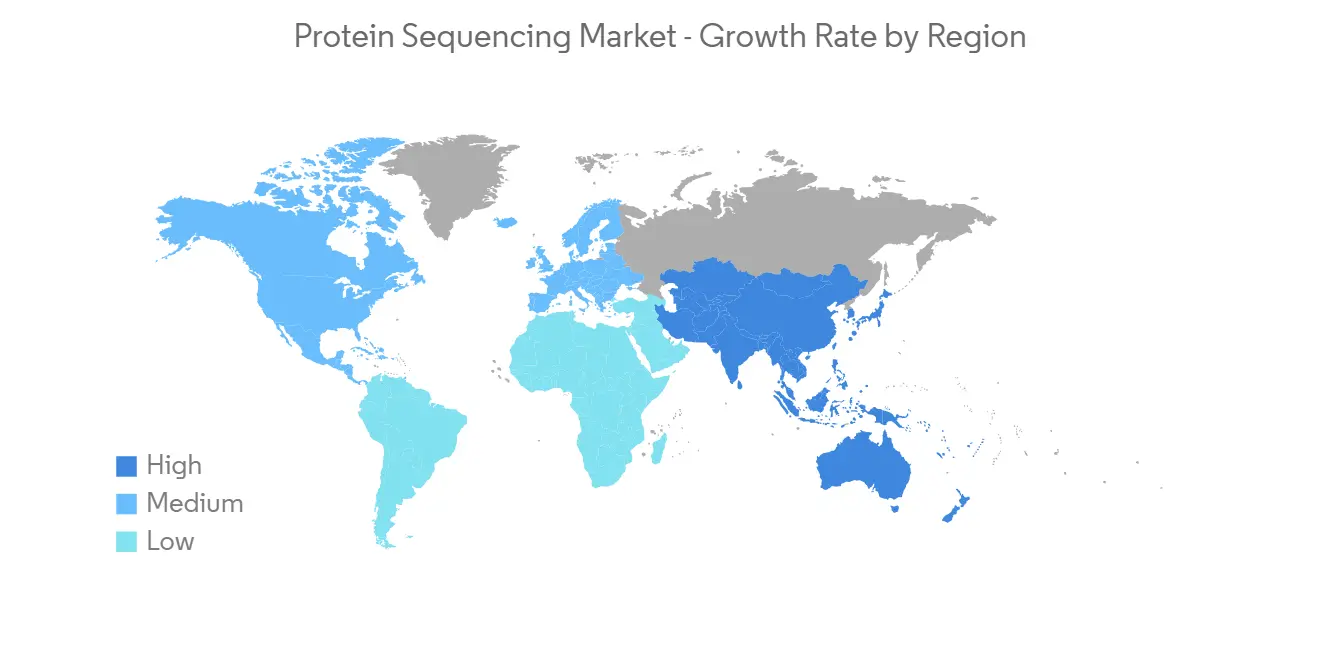 |
市场调查报告书
商品编码
1273445
蛋白质测序市场 - 增长、趋势和预测 (2023-2028)Protein Sequencing Market - Growth, Trends, and Forecasts (2023 - 2028) |
||||||
※ 本网页内容可能与最新版本有所差异。详细情况请与我们联繫。
在预测期内,蛋白质测序市场预计将以 3.6% 的复合年增长率增长。
COVID-19 的检测对市场产生了重大影响,因为它已被蛋白质测序所提供的进步所利用。 例如,正如 2022 年 7 月发表在 Frontiers 上的一篇论文所述,每天存储在生物数据库中的蛋白质序列数量不断增加,病毒株之间的 N 蛋白保守性以及计算方法可能有助于 SARS。-已被使用以确定 CoV-2 和 SARS-CoV 相关病毒的潜在新靶点。 因此,这种用于识别 COVID-19 靶标的蛋白质测序技术在预测期内对市场增长产生了重大影响。 由于蛋白质测序在生物医学研究中的应用越来越广泛,预计未来几年该市场将出现增长。
推动蛋白质测序市场增长的主要因素包括对靶向药物开发的日益关注、技术进步以及蛋白质组学研究资金的增加。 例如,在 2022 年 6 月发表在 ACS Publications 上的一篇论文中,重要的是要了解具有所有特定构象的蛋白质结构,以便选择性地靶向蛋白质和设计小分子。 AlphaFold2 是一种基于深度神经网络的机器学习程序,能够以非常高的准确度预测未知的蛋白质结构,这可能有助于更高效的药物设计。 同样,在 2022 年 9 月发表在 TechRxiv 上的一篇论文中,研究人员提出了一种通过单次二元测量识别大量或少量分子中的单个氨基酸 (AA) 的方法。 它可以与 Edman 降解(或其他方法)结合用于□测序或从子序列中鑑定母体蛋白质。 这种二进制/数字方法基于转移 RNA (tRNA) 的超特异性,与传统的单分子 (SM) 测序方法和使用模拟测量的新方法有很大不同。 因此,预计蛋白质测序领域的此类技术进步将在预测期内推动市场增长。
此外,增加对蛋白质组学研究的资助也有望在预测期内推动蛋白质测序市场的发展。 例如,2021 年 6 月,麻省理工学院分拆出来的 Glyphic Biotechnologies 计划以 600 万美元的种子资金建立一个蛋白质组学平台,以应对蛋白质组学和蛋白□□质分析市场。 此外,2022 年 5 月,Proteomics International Laboratories 根据医学研究未来基金 (MRFF) 计划从澳大利亚政府获得了约 286,833 美元的资助。 预计这笔资金将用于支持 PromarkerD 测试在澳大利亚的生产。
因此,由于蛋白质测序带来的收益增加和研究资金的增加,预计研究市场在预测期内将呈现市场增长。 然而,蛋白质测序设备的高成本预计将抑制预测期内的市场增长。
蛋白质测序市场趋势
蛋白质工程研究有望在预测期内显示蛋白质测序市场的增长
蛋白质工程是操纵蛋白质结构以产生所需特性,或合成具有特定结构的蛋白质。 当今市场上的大多数治疗药物都是生物製剂,例如抗体、核酸製剂和疫苗。 由于蛋白质工程研究活动的增加以及用于开发各种含蛋白质产品的资金增加,预计蛋白质工程领域的市场将出现增长。 例如,2022 年 10 月,上州医学院的一位教授因结合蛋白质和 DNA 工程而获得美国国家综合医学科学研究所超过 150 万美元的奖励。 在这项研究中,我们创建了几个精心挑选的具有强大生物活性的蛋白质开关,并通过选定的 DNA 或 RNA 序列(例如来自冠状病毒和鉅细胞病毒的序列)使用 DNA 工程打开它们。
同样,2022 年 9 月,内华达大学化学与材料工程助理教授宣布,美国国立卫生研究院国家衰老研究所 (NIA) 的一种新型□抑製剂(一种与参与神经退行性疾□□病的□相互作用的分子)工程补助金。 研究人员正在使用最先进的蛋白质工程技术开发基于特定蛋白质的新型□抑製剂,这些蛋白质可抑制与神经退行性疾□□病有关的□。 因此,预计这种以蛋白质工程为动力的调查将在预测期内推动市场增长。 此外,2022 年 3 月,北德克萨斯大学生物医学工程系的研究人员最近获得了 150 万美元的美国国立卫生研究院 (NIH) 最大化研究者研究奖 (MIRA),用于研究蛋白质和细胞工程。 这笔新资金将使研究人员有机会发现和设计生物蛋白质的新功能和特性,最终产生新的生物行为。
因此,预计增加的研究经费和蛋白质工程带来的未来机遇将在预测期内推动该细分市场的增长。

预计在预测期内北美将占很大份额
由于技术不断进步和拥有出色的医疗保健基础设施,预计北美将占据蛋白质测序市场的很大份额。 它还为政府和非政府组织在蛋白质组学领域的研究提供资金。
此外,预计北美主要参与者的企业活动将在预测期内推动市场增长。 例如,2023 年 1 月,总部位于美国的 Quantum-Si 开始商业发货其铂蛋白测序系统,并在第 41 届摩根大通医疗保健会议上提供了业务更新。 该公司已与抗体、蛋白质和免疫分析试剂产品供应商 Aviva Systems Biology 合作,与 Platinum 共同开髮用于蛋白质测序研究工作流程的样品製备试剂盒。
此外,马尼托巴省政府将于 2022 年 6 月发布马尼托巴省蛋白质研究战略,这是一项全面的研究计划,将作为该州在这个快速增长的细分市场取得最终成功的蓝图。 MPRS 专注于可持续蛋白质食品系统的气候变化适应力、新型可持续蛋白质产品的研发和加工、支持可持续食品系统的数字农业、废物、水、副产品 46 个战略研究项目分为四个主题,替代用途。
因此,由于研究资金的增加和蛋白质测序技术的进步,预计北美在预测期内的监测市场将出现增长。

蛋白质测序行业概况
由于存在各种市场参与者,这个市场是分散的。 预计主要参与者的合併、收购、联盟和合作伙伴关係等战略活动将在预测期内推动市场增长。 一些市场参与者是 Agilent Technologies, Inc.、Bioinformatics Solutions、Charles River Laboratories、Proteome Factory、Rapid Novor Inc.、Selvita SA、SGS SA、Shimadzu Corporation、Thermo Fisher Scientific Inc.、Waters。
其他福利:
- Excel 格式的市场预测 (ME) 表
- 3 个月的分析师支持
内容
第一章介绍
- 调查假设和市场定义
- 本次调查的范围
第二章研究方法论
第 3 章执行摘要
第四章市场动态
- 市场概览
- 市场驱动因素
- 越来越关注基于靶点的药物开发
- 增加对蛋白质组学研究的资助
- 市场製约因素
- 蛋白质测序仪成本高
- 波特五力
- 新进入者的威胁
- 买方/消费者议价能力
- 供应商的议价能力
- 替代品的威胁
- 竞争公司之间的敌对关係
第 5 章市场细分
- 按产品/服务
- 乐器
- 质谱仪
- 埃德曼分解
- 试剂和耗材
- 软件服务
- 乐器
- 通过申请
- 生物标誌物发现
- 蛋白质工程研究
- 生物疗法
- 其他
- 最终用户
- 製药公司、生物技术公司
- 研发中心
- 其他
- 按地区
- 北美
- 美国
- 加拿大
- 墨西哥
- 欧洲
- 德国
- 英国
- 法国
- 意大利
- 西班牙
- 其他欧洲
- 亚太地区
- 中国
- 日本
- 印度
- 澳大利亚
- 韩国
- 其他亚太地区
- 中东和非洲
- 海湾合作委员会
- 南非
- 其他中东和非洲地区
- 南美洲
- 巴西
- 阿根廷
- 其他南美洲
- 北美
第六章竞争格局
- 公司简介
- Agilent Technologies, Inc.
- Bioinformatics Solutions
- Charles River Laboratories
- Proteome Factory
- Rapid Novor Inc.
- Selvita SA
- SGS SA
- Shimadzu Corporation
- Thermo Fisher Scientific Inc.
- Waters Corporation
- Alphalyse
- Bruker
第七章市场机会与未来趋势
The protein sequencing market is expected to register a CAGR of 3.6% over the forecast period.
COVID-19 has had a significant impact on the market since the detection of COVID-19 was utilized by the advancements offered by protein sequencing. For instance, as per the article published in July 2022 in Frontiers, the growing number of protein sequences deposited in biological databases on a daily basis, as well as the N protein conservation among viral strains along with computational approaches, were used to identify possible novel targets for SARS-CoV-2 and SARS-CoV-related viruses. Hence, such protein sequencing techniques for identifying the COVID-19 targets significantly impacted the market growth over the forecast period. The market is anticipated to witness growth in the coming years due to the increase in the utilization of protein sequencing in biomedical research.
The major factors for the growth of the protein sequencing market include the rising focus on target-based drug development and technological advancements and increasing funding for proteomics research. For instance, as per the article published in June 2022 in ACS Publications, to selectively target a protein and to design small molecules, knowing the protein structure with all its specific conformation is critical. AlphaFold2, a deep neural network-based machine learning programme, was able to predict unknown protein structures with exceptional accuracy and which helped the drug design more efficiently. Similarly, as per the article published in September 2022 in TechRxiv, the researchers presented a method for identifying single amino acids (AAs) in bulk or with a few molecules from a single binary measurement. It can be used in conjunction with Edman degradation (or another approach) to sequence a peptide or identify the parent protein from a partial sequence. This binary/digital methodology is based on the super specificity property of transfer RNAs (tRNAs), and it differs significantly from the traditional and newer single molecule (SM) sequencing approaches that use analog measurements. Hence, such technological advancements in the field of protein sequencing are likely to fuel market growth over the forecast period.
Furthermore, the rising funding for proteomic research is expected to boost the protein sequencing market over the forecast period. For instance, in June 2021, with USD 6 million in Seed Funding, MIT Spinout Glyphic Biotechnologies planned to build a proteomic platform to tackle the proteomics and protein analysis market. Additionally, in May 2022, Proteomics International Laboratories was awarded approximately USD 286,833 in funding from the Australian Government under the Medical Research Future Fund (MRFF) initiative. The funding is expected to support manufacturing the PromarkerD test in Australia.
Thus, due to the rise in advantages offered by protein sequencing and the increase in research funding, the studied market is anticipated to witness growth in the market over the forecast period. However, the high cost of protein sequencing equipment is anticipated to restrain the market growth over the forecast period.
Protein Sequencing Market Trends
Protein Engineering Studies are Expected to Witness a Growth in the Protein Sequencing Market Over the Forecast Period
Protein engineering is the manipulation of the structures of proteins to produce the desired properties or the synthesis of proteins with particular structures. The majority of therapeutic drugs in the current market are bio formulations, such as antibodies, nucleic acid products, and vaccines. The protein engineering segment is anticipated to witness growth in the market due to the rise in research activities in protein engineering and an increase in funding for developing different products involving proteins. For instance, in October 2022, the Upstate Medical University professor was awarded more than USD 1.5 million from the National Institute of General Medical Sciences for combining protein and DNA engineering. In the study, the researcher is building a few select protein switches that have powerful biological activities and using DNA engineering to turn on those activities by DNA or RNA sequences of choice, such as those from coronavirus or cytomegalovirus.
Similarly, in September 2022, a Chemical & Materials Engineering assistant professor at the University of Nevada, received a grant from the NIH's National Institute on Aging (NIA) to engineer novel enzyme inhibitors (molecules that interact with enzymes that play a role in neurodegenerative disease. The researcher is developing novel enzyme inhibitors using state-of-the-art protein engineering techniques based on a specific protein that will block the enzymes that play a role in neurodegenerative diseases. Hence, such research studies utilizing protein engineering are anticipated to drive market growth over the forecast period. Furthermore, in March 2022, the University of North Texas Department of Biomedical Engineering researcher recently received a USD 1.5 million National Institutes of Health (NIH) Maximizing Investigators' Research Award (MIRA) to study protein and cellular engineering. The new funding allows the researcher the opportunity to discover and design new functions and properties in biological proteins to ultimately generate new biological behavior.
Thus, an increase in research funding and a rise in future opportunities offered by protein engineering is anticipated to drive the segment growth over the forecast period.

North America is Expected to Hold Significant Market Share Over the Forecast Period
North America is expected to hold a significant share of the protein sequencing market owing to rising technological advancements and the presence of better healthcare infrastructure. Also, government and non-government organizations are providing funds to carry out research in the field of proteomics.
Furthermore, company activities by key players in North America are expected to drive market growth over the forecast period. For instance, in January 2023, United States-based Quantum-Si began commercial shipments of the platinum protein sequencing system and provided business updates at the 41st Annual J.P. Morgan Healthcare Conference. The company partnered with Aviva Systems Biology, a provider of antibody, protein, and immunoassay reagent products, to co-develop sample preparation kits for protein sequencing research workflows with Platinum.
Furthermore, in June 2022, Manitoba Government unveiled the release of the Manitoba Protein Research Strategy, a comprehensive research plan that will form the blueprint for the province's ultimate success in this burgeoning market segment. The MPRS highlights 46 strategic research projects under four main themes, including climate resilience of sustainable protein food systems, novel sustainable protein product development and processing, digital agriculture to enable sustainable food systems, and waste, water, by-product, and co-product utilization.
Thus, due to the rise in research funding, and the increase in technological advancements in protein sequencing, North America is anticipated to witness growth in the studied market over the forecast period.

Protein Sequencing Industry Overview
The market studied is a fragmented market owing to the presence of various market players. Strategic activities such as mergers, acquisitions, collaboration and partnerships by the key players are likely to bolster the market growth over the forecast period. Some of the market players are Agilent Technologies, Inc., Bioinformatics Solutions, Charles River Laboratories, Proteome Factory, Rapid Novor Inc., Selvita SA, SGS SA, Shimadzu Corporation, Thermo Fisher Scientific Inc., and Waters.
Additional Benefits:
- The market estimate (ME) sheet in Excel format
- 3 months of analyst support
TABLE OF CONTENTS
1 INTRODUCTION
- 1.1 Study Assumptions and Market Definition
- 1.2 Scope of the Study
2 RESEARCH METHODOLOGY
3 EXECUTIVE SUMMARY
4 MARKET DYNAMICS
- 4.1 Market Overview
- 4.2 Market Drivers
- 4.2.1 Rising Focus on Target based Drug Development
- 4.2.2 Increasing Funding for Proteomic Research
- 4.3 Market Restraints
- 4.3.1 High Cost of Protein Sequencing Equipment
- 4.4 Porter Five Forces
- 4.4.1 Threat of New Entrants
- 4.4.2 Bargaining Power of Buyers/Consumers
- 4.4.3 Bargaining Power of Suppliers
- 4.4.4 Threat of Substitute Products
- 4.4.5 Intensity of Competitive Rivalry
5 MARKET SEGMENTATION (Market Size by Value - USD Million)
- 5.1 By Products and Services
- 5.1.1 Instruments
- 5.1.1.1 Mass Spectrometry
- 5.1.1.2 Edman Degradation
- 5.1.2 Reagents and Consumables
- 5.1.3 Softwares and Services
- 5.1.1 Instruments
- 5.2 By Application
- 5.2.1 Biomarker Discovery
- 5.2.2 Protein Engineering Studies
- 5.2.3 Biotherapeutics
- 5.2.4 Others
- 5.3 By End User
- 5.3.1 Pharmaceutical and Biotechnology Companies
- 5.3.2 Research Centers
- 5.3.3 Others
- 5.4 Geography
- 5.4.1 North America
- 5.4.1.1 United States
- 5.4.1.2 Canada
- 5.4.1.3 Mexico
- 5.4.2 Europe
- 5.4.2.1 Germany
- 5.4.2.2 United Kingdom
- 5.4.2.3 France
- 5.4.2.4 Italy
- 5.4.2.5 Spain
- 5.4.2.6 Rest of Europe
- 5.4.3 Asia Pacific
- 5.4.3.1 China
- 5.4.3.2 Japan
- 5.4.3.3 India
- 5.4.3.4 Australia
- 5.4.3.5 South Korea
- 5.4.3.6 Rest of Asia-Pacific
- 5.4.4 Middle East and Africa
- 5.4.4.1 GCC
- 5.4.4.2 South Africa
- 5.4.4.3 Rest of Middle East and Africa
- 5.4.5 South America
- 5.4.5.1 Brazil
- 5.4.5.2 Argentina
- 5.4.5.3 Rest of South America
- 5.4.1 North America
6 COMPETITIVE LANDSCAPE
- 6.1 Company Profiles
- 6.1.1 Agilent Technologies, Inc.
- 6.1.2 Bioinformatics Solutions
- 6.1.3 Charles River Laboratories
- 6.1.4 Proteome Factory
- 6.1.5 Rapid Novor Inc.
- 6.1.6 Selvita SA
- 6.1.7 SGS SA
- 6.1.8 Shimadzu Corporation
- 6.1.9 Thermo Fisher Scientific Inc.
- 6.1.10 Waters Corporation
- 6.1.11 Alphalyse
- 6.1.12 Bruker











